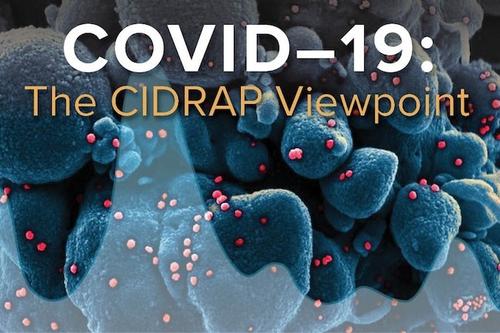In new report, CIDRAP at the University of Minnesota calls for a directed, unified approach to COVID-19 surveillance

According to the U.S. Centers for Disease for Control and Prevention (CDC), disease surveillance includes the ongoing and systematic collection, analysis and interpretation of data on the occurrence of disease in the population. Surveillance is the cornerstone of public health practice because it allows public health officials to identify opportunities for disease control and evaluate the impact of policies and interventions.
For surveillance to have a meaningful impact, the data collected from the surveillance system must be organized and analyzed in a thoughtful, structured way, and the results must be communicated regularly, clearly and effectively to the public health workforce, policy makers and the public.
But, according to a new report from the Center for Infectious Disease Research and Policy (CIDRAP) at the University of Minnesota, the lack of consistent methods and strategies for conducting COVID-19 surveillance across the country has hamstrung response efforts.
“SARS-CoV-2 Infection and COVID-19 Surveillance: A National Framework,” the fifth report in a multipart series titled, "COVID-19: The CIDRAP Viewpoint," was published today. The report identifies key challenges to the effective implementation of COVID-19 surveillance and recommends several steps for a directed, unified approach to COVID-19 surveillance to effectively guide public health decisions for response efforts going forward.
Testing is a key feature of an effective surveillance system, but the lack of consistent, widespread access to testing within and between states complicates the meaningful interpretation of data at the state and national levels. Data collected at the jurisdiction level are not reported quickly and uniformly across the country. State-level data do not always include critical elements, such as the number of cases, hospitalizations and deaths, nor additional important demographic information such as age, gender, race/ethnicity and location.
COVID-19 surveillance systems lack flexibility to adapt and become more targeted as the changing epidemiology of COVID-19 is clarified (e.g., identification of higher-risk populations, environments, activities and behaviors). Comprehensive surveillance data, including the race and ethnicity of each patient, are needed to address racial and ethnic COVID-19-related disparities.
Lastly, efforts are needed to expand serosurveillance across the country using comparable methods as part of a national strategy.
In the report, CIDRAP recommends:
- A state-by-state assessment of COVID-19 surveillance practices needs to be conducted to identify inconsistencies in timely case detection and reporting and to determine resource needs. Since the Council of State and Territorial Epidemiologists (CSTE) establishes and implements the use of national case definitions, it should conduct this review in collaboration with the CDC.
- Information from this assessment can then be used to develop a national standardized approach to COVID-19 surveillance by states. The approach needs to adapt to the changing epidemiology of the pandemic and as new data on the nature of the disease are published.
- Automated electronic reporting should be incorporated into surveillance whenever possible, and the federal government needs to provide the additional resources needed to develop such systems.
- States should publish on their COVID-19 dashboards standardized and detailed data for demographic subgroups defined by combinations of age, gender, race/ethnicity and location. These should be publicly available for different periods so that temporal trends can be analyzed.
- A coordinated campaign at the federal, state or territorial level with consistent guidance from the CDC regarding key messages is needed to inform and educate applicable facilities (e.g., commercial and clinical laboratories, healthcare providers and facilities) on what information is required and why it is important.
- State and local health departments need to have the data systems, informatics expertise and trained epidemiologists necessary to conduct effective COVID-19 surveillance. This includes upgrading data surveillance infrastructure and ensuring federal support to provide resources needed to accomplish this goal.
- The CDC should implement the agency’s serosurveillance program as quickly as possible.
- The CDC should continue to promote consistency for COVID-19 surveillance across the country and ensure that a cohesive national surveillance system emerges by the end of 2020.
- With the fall influenza season approaching, federal, state, local and territorial health officials need to begin now to determine strategies for coordinating surveillance for both COVID-19 and influenza.
“Accurate and timely surveillance data are critical to ultimately controlling the COVID-19 pandemic here in the United States,” said Michael Osterholm, Ph.D., M.P.H., CIDRAP director, University of Minnesota Regents Professor and McKnight Presidential Endowed Chair in Public Health. “It’s also essential that we have data that can be compared across states and over time, so we can assess the impact of various public health interventions.”
Future reports in the "COVID-19: The CIDRAP Viewpoint" series will address respiratory protection, supply chain issues and other key topics.
COVID-19 is a respiratory illness that was first identified in Wuhan, China, in December 2019. Confirmed U.S. cases recently topped 3 million, and the global total has now topped 12 million confirmed infections, including more than 550,000 deaths.
The Viewpoint reports are made possible with support from the University of Minnesota Office of the Vice President for Research and the Bentson Foundation.
-30-
About the Center for Infectious Disease Research and Policy
The Center for Infectious Disease Research and Policy is a global leader in addressing public health preparedness and emerging infectious disease response. Founded in 2001, CIDRAP is part of the Office of the Vice President for Research at the University of Minnesota.




